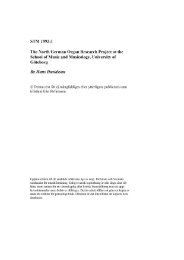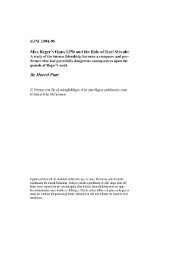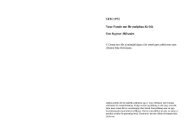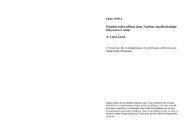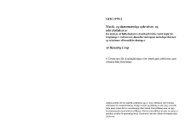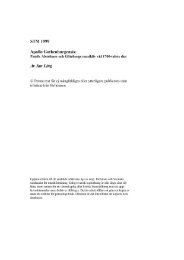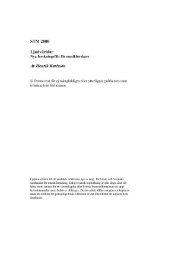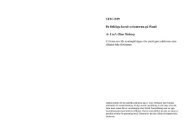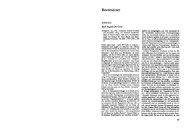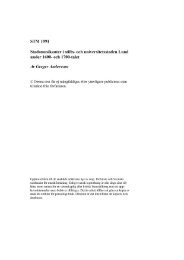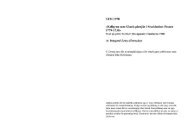Nicolai
Nicolai
Nicolai
Create successful ePaper yourself
Turn your PDF publications into a flip-book with our unique Google optimized e-Paper software.
Hartmann believed that the world could be investigated and understood as a<br />
system, but was just as convinced that the days of speculative metaphysical system-<br />
building were over. In the foreword to his book Der Aufbau der reden Welt<br />
(1940) he writes, ”Ich höre immer wieder den Vorwurf, ich hatte der Philosophie<br />
das Recht, auf ein ’System’ hinzuarbeiten, abgesprochen, täte dabei aber selbst<br />
nichts anderes als ein philosophisches System zu bauen.” (P. VI.) He answers his<br />
critics, however: ”Da ist doch den Herren Kritikern ein mir kaum begreifliches<br />
Missverständnis untergelaufen. Sie haben das System der Welt mit dem System<br />
der Philosophie, das Suchen nach ersterem mit dem fabulierenden Gedankenspiel<br />
des letzteren verwechselt. Niemals habe ich bestritten, dass die Welt, in der wir<br />
leben, ein System ist, und dass die philosophische Erkenntnis dieser Welt auf Er-<br />
kenntnis ihres Systems hinauslaufen muss. Bestritten habe ich stets nur, dass solche<br />
Erkenntnis von einem vorentworfenen Systemplane ausgehen dürfe-gleich als<br />
wüssten wir schon vor aller Untersuchung, wie das Weltsystem beschaffen ist-,<br />
um dann hinterher die Phänomene hineinzuzwängen, soweit das geht, und abzu-<br />
weisen, soweit es nicht geht. Dieses haben die spekulativen Systeme der Metaphysik<br />
von den Anfangen der Philosophie bis auf unsere Zeit getan. Darum hat sich<br />
keines von ihnen halten können. Systeme dieser Art sind es, die m. E. in der Tat<br />
heute ausgespielt haben.” (P. VIII.)<br />
Hartmann’s conception of knowledge2 is probably pretty much the same as<br />
that of the ordinary man. There is a basic separation (gegenseitige Urgeschieden-<br />
heit) between the knower (subject) and the known (object), which is called ”trans-<br />
cendence’’. Knowledge consists in a ”siezing” (erfassen) of an object. Being-in-<br />
itself becomes an object when it is ”objiziert” or exposed to a subject The subject<br />
reaches out, siezes, and gathers in information about the object. What is brought<br />
back is, of course, not the object itself but an image (Bild) of the object<br />
Hartmann’s theory of culture is given its most extensive treatment in Das<br />
Problem des geistigen Seins (1933). An examination of the structure of the world<br />
reveals the following strata: matter and physical processes, the realm of the or-<br />
ganic, the human soul, and spirit (Geist). This last realm of being can be under-<br />
stood to include, besides knowledge and the laws of logic, ”die Sphäre des Wollens<br />
und Handelns, der Wertung, des Rechts, des Ethos, der Religion, der Kunst” (p.<br />
14). Each stratum has its own principles or categories and the being of each stra-<br />
tum can be comprehended only from the standpoint of its own categories: ”Das<br />
Reich der Kategorien ist nicht monistisch angelegt; Erklärung der ganzen Welt<br />
aus einem Prinzip oder Prinzipiengruppe ist ein Ding der Unmöglichkeit. Wo<br />
und wie immer sie versucht wird, da fuhrt sie zur Vergewaltigung kategorialer<br />
Eigenart (P. 15). Futhermore, in the structure of the world, the higher strata<br />
are borne (getragen) by the lower strata. In this sense, the higher strata do<br />
not have independent being, but only ”aufruhendes Sein”-i.e. they ”rest upon”<br />
the lower strata. ”Man kann dieses Aufruhen als durchgängige Abhängigkeit<br />
des Höheren vom Niederen verstehen: ohne materielle Natur kein Leben, ohne<br />
2 Grundzüge einer Metaphysik der Erkenntnis (1921). See also Das Problem des geistigen<br />
Seins, Chapter 10, ”Die Objektivität” (pp. 99-106).<br />
Leben kein Bewusstsein, ohne Bewusstsein keine geistige Welt.” (P. 15.) Although<br />
the lower categories are the stronger and the higher are dependent on them,<br />
the higher are nonetheless autonomous: ”Die besondere Gestaltung und Eigenart<br />
der höheren [strata} hat Über ihr {the lower) unbegrenzten Spielraum. Das<br />
Organische ist zwar getragen vom Materiellen, aber sein Formenreichtum und<br />
das Wunder der Lebendigkeit stammen nicht aus ihm her, sondern treten als<br />
ein Novum hinzu. Ebenso ist das Seelische über dem Organischen, das Geistigen<br />
über dem Seelischen ein Novum. Dieses Novum, das mit jeder Schicht neu ein-<br />
setzt, ist nichts anderes als die Selbständigkeit oder ’Freiheit’ der höheren Kate-<br />
gorien über den niederen.” (P. 15.)<br />
There are three forms of spirit (types of cultural being): ”der personale Geist”,<br />
i. e. the person as a cultural human being who works his way up from a state of<br />
vital instincts and tension (Spannung) to the realm of consciousness and freedom,<br />
who achieves a ”Distanz zur Sache” and orients himself objectively in the world;<br />
”der objektive Geist”, which includes the realms of language, science, law, morals,<br />
life-style, religion, art, and technology-in other words a ”Weltanschauung”; and<br />
”der objektivierte Geist” (objectified spirit)-created works of art and thought<br />
which are passed on to each succeeding generation. These have being and meaning<br />
”for” a human being who can understand them and they bear witness of the ”Zeit-<br />
geist” of former epochs. Moreover, there is a struggle between the living and<br />
objectified spirits (Ringen des lebenden Geistes mit dem objektivierten) which we<br />
recognize as that eternal ”Auseinandersetzung” of the new with the old, the revo-<br />
lutionary against the conservative. In this way the living spirit can free himself<br />
from the ”Fessel des Geistes” (fetters of the spirit), i. e. reject what is not genuine<br />
in a ”Weltanschauung” but preserve what is valuable in tradition. Thus, art can<br />
be a kind of ”Selbstbefreiung” from that which burdens and oppresses.<br />
The primary source for Hartmann’s philosophy of music is his Ästhetik (1953),<br />
although he does touch briefly upon music in Das Problem des geistigen Seins.<br />
The former work, which was published posthumously and edited by his wife, Frida,<br />
appears in only about one-third of the final draft. This book not only includes<br />
ontological investigations of the arts in general but also deals with the structure<br />
of the aesthetic act and object. I will present here some results of the investigations<br />
concerning the aesthetic act and object and extract from the book the more im-<br />
portant thoughts on the art of music.<br />
The philosophical attitude of the aesthetician differs from the visionary attitude<br />
of the creative artist and from that of a person experiencing a work of art. Ӏsthe-<br />
tik ist eine Art Erkenntnis, und zwar mit der echten Tendenz, Wissenschaft zu<br />
werden.” (Ästhetik, p. 1.) The object of this knowledge is just that artistic ex-<br />
perience and visionary attitude, and also the beautiful. It is a mistake to assume<br />
that the aesthetical ”view” (Anschauung) is a comprehension (Erfassen) in the<br />
same way that the comprehension of knowledge is. This theory was held by Alex-<br />
ander Baumgarten (with his ”cognitio”) and Schopenhauer. Nevertheless there<br />
is an element of ”Erkennen” in the aesthetical ”Schau” or ”viewing” and that is<br />
the sensual perception which is the basis of the act. But other act-elements are<br />
more characteristic of this ”Schau”, namely evaluation (Bewertung), being attrac-



